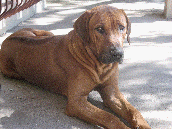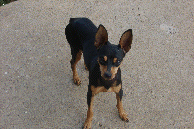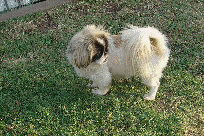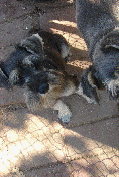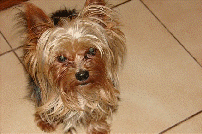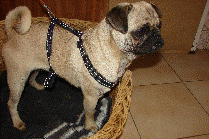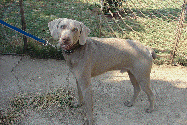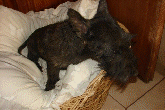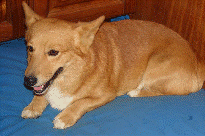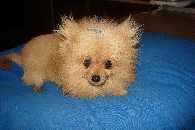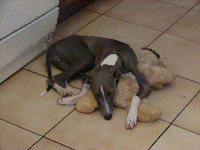Dog Breeds M - Z
Pembroke Welsh Corgi
The Pembroke Welsh Corgi is a small-to medium-sized dog breed although it acts more like a “big dog” on short legs. The Pembroke has a fairly strong body with short strong legs and either no tail or a shortened tail which is usually docked in countries that permit it. The Cardigan Welsh Corgi can be distinguished from its cousin, the Pembroke, because it has a longer body and a brush-like tail. Both these Welsh Corgi dog breeds have fox-shaped faces and medium to large-sized ears that are slightly rounded and erect. The Pembroke has a medium length water-resistant coat. Colors can be red, beige, or black-and-tan; with or without white markings on the chest neck and legs. The Pembroke stands about 10-12 inches at shoulder height and weighs from 18 to 24 pounds.
The Pembroke is an energetic, agile, intelligent, gentle and loving dog. The Pembroke is devoted to its family and makes a terrific companion dog. Pembroke's are calmer than Cardigans and tend to be a little less accepting of unfamiliar people and dogs. Pembroke's get along fine with older considerate children but not toddlers or very young children. This breed is very intelligent and can be easily trained to respond to voice commands or for agility competitions. The Pembroke makes a good watchdog and is suitable for first-time dog owners.
The Pembroke enjoys a moderate amount of exercise and likes to be kept busy. The breed loves to play ball and participate in agility games and competitions. The Pembroke is quite adaptable and can live in an apartment as long as it gets outside for exercise.
The Pembroke’s coat needs little grooming beyond a weekly brushing except when shedding and a daily brushing is required. This breed is a moderate shedder.
Pekingese
The Pekingese or Peke has quite a sturdy and strong build for a small toy dog breed. The breed is characterized by a lion-like appearance with a broad chest and straight back. The Peke has a very flat face with a snub nose, and wide set eyes. The tail is set high and carried curled over the back. The Peke has a long, straight, coarse outer coat and a thick undercoat. The coat has a profuse mane with feathering on the ears, legs, tail and feet. The Peke’s colors are usually beige and black sometimes combined with white but all colors are allowed. Peke’s are a small toy breed and stand about 7 to 8 inches tall at shoulder height and can weigh from 8 to 13 pounds.
The Pekingese seems to believe in its royal heritage and is a dignified, regal, confident and stubborn dog. The Peke is fearless, good-tempered and not aggressive. Pekes are fairly quiet and are not particularly fond of children or strangers. Pekes should be thoroughly socialized and trained otherwise they will rule the household. Training is difficult because the Peke’s sensitive and headstrong nature make it a real challenge. However lots of praise and attention can achieve results. Peke’s are real characters and can be very enjoyable companions.
Pekes will adapt quite well to apartment living and need very little exercise beyond what they get inside the apartment. Pekes do not like long walks but will accept shorter walks a few times per day. Pekes do poorly in warm humid weather and prefer their air-conditioned comfort.
The coat of a Pekingese requires intensive grooming. You must train the Peke while it is a puppy to enjoy the grooming process otherwise it will become an unhappy process every time you bring out a brush and comb. Pay attention to the feathered areas where the tangles form. The facial creases should be cleaned and the excess hair clipped from between the paw pads. The Peke should have dry shampoo to talcum powder applied to the coat during grooming.
The Whippet is a medium-sized dog and looks very much like a small Greyhound. They are part of the sight hound family of dog breeds which means they hunt purely by sight, not smell. The Whippet’s body is perfect for racing. Over short distances it can reach speeds up to 35 mph. The male of this dog breed stands 18 to 22 inches tall at shoulder height and 17 to18 inches for females. Their weight range is from 20 to 30 pounds. Built for racing the Whippet’s legs are well muscled, with strong bones and it has a long thin tail. The Whippet has a long narrow head that tapers to its nose. This dog’s ears are small and very mobile, flopping over slightly when not in use. This breed’s coat is short and smooth and can come in many colors.
The Whippet gets along well with children and makes a good family dog. This breed is good natured, gentle and very playful. As well this dog can be easily trained, sheds very little and is a great size for an apartment. Although it is important to know that Whippets do like and even expect to sit on furniture -so that should not be a concern if you are considering this breed. This breed is most happy when it gets to live with one or more other Whippets. A Whippet puppy can be very destructive, but the dog will quickly mellow as it gets older. This breed is initially wary of strangers but can quickly be convinced that they are friends. This makes them not very useful as a watchdog. Whippets are excellent at coursing and racing. Whippet racing is a hobby which makes it very different from Greyhound racing. There is no prize money or gambling involved. The Whippet is also good at fly ball, obedience, agility and Frisbee competitions.
This dog loves games that involve running and needs short periods of vigorous exercise each day. Because the Whippet is so fast they should have a fenced area to play in. The Whippet should wear a sweater in cold weather.
The Whippet’s coat needs very little grooming and sheds very little.
Miniature Whippet
Miniature Pincher
The Miniature Pinscher or Min Pin is the most active and lively of all the toy dog breeds. Min Pins are fairly sturdy but look sleek and elegant and move with a high-stepping confident gait. This toy dog has a narrow head with natural floppy ears that are usually cropped to stand erect while the tail is always docked. The Min Pin’s coat is short, smooth and lustrous. Colors can be: solid red; solid chocolate-brown; black with rust markings; or chocolate-brown with rust markings. The Min Pin stands 10 to 12 inches tall at shoulder height and weighs 8 to 12 pounds.
Miniature Pinschers are full of energy, alert, loyal, intelligent and very courageous for their size. Min Pins think they are much larger than their toy size and can be aggressive towards other dogs. These toy dogs can be stubborn and need lots of early socialisation and obedience training while puppies. However, these dogs are intelligent and can be trained if you are patient. The Min Pin doesn’t like rough handling and could bite small children or toddlers that are too rough with it. The breed does fine with older considerate children and household pets. Min Pins, like all toy dogs, are difficult to housetrain. This toy breed loves to cuddle and hide under a blanket in your bed. Outdoors, this toy breed should be on a leash or in a securely fenced yard as they can disappear quickly. Min Pins do not like strangers or strange dogs and make very good watchdogs.
Miniature Pinschers will meet most of their exercise requirements through playing indoors. Min Pins make good apartment dogs when properly trained. This toy breed likes to go on walks and should be kept on a leash with harness or wide collar. They are sensitive to cold and should wear a sweater in cold weather.
The Min Pin doesn’t require much grooming beyond wiping with a damp cloth to shine up the coat. This breed is a light to moderate shedder. During shedding season, use a rubber brush to remove loose hair.
Miniature Snauzer
Pug
The Pug or Chinese Pug is a sturdy small dog that is one of the most popular and largest of the toy dog breeds. Pug puppies rank 10+ out of 10 on the cuteness scale. Pugs are readily identifiable by their: flat face; pug nose; large and round head with a wrinkled muzzle; loose but not wrinkled skin; and a distinctive tail that curls tightly over one hip. The Pug’s outer coat is short, soft and glossy with a very fine under coat. The color can be black, silver, or apricot fawn and all varieties have a black mask and ears. The Pug is well muscled with straight legs and a slightly rolling gait. This small dog breed stands about 10 to 11 inches tall at shoulder height and should weigh from 14 to 18 pounds.
This charming, adorable and playful small dog will make you laugh. The Pug is an even tempered, easygoing, pleasant and friendly companion. This sturdy, small dog breed gets along well with children and with other pets although toddlers and small children should be supervised carefully to ensure they don’t injure the dog. The Pug doesn’t need much training but enjoys the process and is fairly easy to train. Pugs can be difficult to housebreak in rainy or cold weather but you must persevere. Pugs are very childlike and always want to be with you. They are very easy to spoil but somehow manage to keep their sweet disposition. Pugs make fairly good watchdogs and will give their strange bark when strangers approach.
Pugs are low maintenance dog breeds and get enough exercise playing indoors. They are well suited for apartment living. Pugs have a tendency to put on weight and should be taken for walks when the weather isn’t too hot. Pugs are short-muzzled dogs and suffer breathing problems in hot and humid conditions. Pugs love to be air conditioned in warm weather. Pugs have trachea that are subject to injury so a harness is recommended instead of a collar.
Pugs require little grooming but they are heavy shedders for their size. Brush regularly with a bristle brush or grooming glove. The folds in their face should be cleaned on a daily basis. Bathe monthly with a natural and mild shampoo – rinsing thoroughly..
Pomeranian
Pomeranians or “Poms” are one of the smallest toy dog breeds. Pomeranian puppies are hard to resist and rank 10 out of 10 on the cuteness scale. The Pomeranian dog has a short body, a fox-like V-shaped head, prick ears, straight legs and a tail that turns over its back in Spitz fashion. The Pom is double coated and its harsh, straight outer coat covers a soft, fluffy and full undercoat. The overall impression is one of an elegant ball of fluff from which the Pom’s legs stick out. The feathered legs, chest, loins and tail give the breed a luxurious look. The coat can be any single color including: white, cream, orange, red, brown or black or any particolor. The nose is usually black. Pomeranians stand 7 to 9 inches tall at shoulder height and can weigh from 3 to 7 pounds.
The Pom is lively, spirited and animated. This breed is a keen-eyed extrovert who is very inquisitive and must check out all activities going on around him. The Pom is a proud and confident, even cocky, toy dog that requires early and thorough socialization with strangers to minimize its tendency to bark. Pomeranians don’t do well with small children or toddlers as they are just too small and can be candidates for accidental injury. Poms will chase larger dogs and you have to protect them from themselves. This toy breed is intelligent, eager to learn and takes readily to positive and gentle training methods. Poms, like most toy breeds, can be difficult to housetrain so you must persevere early. Make sure to socialize and train your Pom early to control his barking which can be a very annoying problem. Pomeranians make good watchdogs as they will bark if they hear strangers.
Poms will get sufficient exercise running and playing inside but outside walks are greatly enjoyed and appreciated. Remember to always use a harness, not a collar as Poms are subject to tracheal collapse.
The Pomeranian’s coat needs brushing and trimming once a week. Poms are heavy shedding dog breeds. Male Poms blow their coat once a year and females twice a year, and they can look pretty patchy. Don’t worry it will grow back again! Brush the coat with a slicker or pin brush – working from the head down. Try and tease out any tangles with a coarse comb. Be careful not to brush and comb too often as you can damage the undercoat. Only give Poms a wet bath when they have blown their coats, otherwise use a dry shampoo.
Rhodesian Ridgeback
The Rhodesian Ridgeback, also known as the African Lion Dog or Rhodesian Lion Dog, is a lean, well muscled and magnificent, large dog breed. The Rodesian Ridgeback gets its name from a characteristic ridge running down the dog’s back, where the stiff hair grows in the opposite direction from the rest of the coat. The ridge starts immediately behind the shoulders, where there are two whorls directly opposite each other, and continues along the dogs back to a point between the hips. The Ridgeback has an extremely strong body with a deep and well-ribbed chest; a large head with high-set droop ears that taper to a rounded point; round wide-set dark brown or amber eyes; and a long and strong tapered tail. The Ridgeback’s coat is short, hard, dense, sleek and glossy. Coat colors range from light wheaten to red wheaten. Male Ridgebacks stand 25 to 27 inches and females 24 to 26 inches tall at shoulder height. Males weigh from 70 to 85 pounds and females from 60 to 75 pounds.
The Ridgeback is indigenous to South Africa. The only dog known to have a ridge growing in the opposite direction was the Phu Quoc, from an Asian island, which may have been brought to Africa by Phoenician traders. This ridge is characteristic of the half wild African Hottentot Hunting dog and it is assumed that these dogs were crossed with other hunting dogs brought to South Africa by immigrants. Any number of breeds, such as the Mastiff, Great Dane, and Bloodhound, could have been involved in the Ridgeback’s development. The Ridgeback developed into a very intelligent hound of great strength and courage that could go without water for extended periods of time and could cope with the extreme temperatures of the African landscape. Ridgebacks became outstanding hunting dogs that were used in packs to hunt antelope, buffalo, leopards and lions.
The Ridgeback is dignified, trustworthy, loyal, and intelligent and makes a great family pet. It is extremely protective of its immediate family and has a streak of independence – probably left over from its hunting background. Ridgebacks are very good with children, especially when raised with them. However young Ridgebacks can be too rambunctious for small children and toddlers. Ridgebacks are wary of strangers and also other animals and must be thoroughly socialized and obedience trained while a puppy. This training should be continued through adolescence and even into adulthood to minimize any aggressive tendencies. This dog breed is too large and too strong to not be thoroughly obedience trained. Because the Ridgeback is so intelligent and somewhat independent, training can be difficult and needs to be re-enforced often. This breed is very confidant and will test members of the family to try and find his place in the family hierarchy. Overall the Ridgeback makes a wonderful companion and family dog as long as you let him know you are in charge. Ridgeback’s don’t bark much but make great watchdogs.
Rhodesian Ridgebacks need lots of exercise and do best with a large yard. Two runs per day are ideal but one long walk per day will suffice if you have a large yard. Remember that Ridgebacks are hounds with good sight and smell and love to participate in agility, lure-coursing and other tracking events. See our article on “Fun Dog Activities” for information on these and other activities. Mature Ridgebacks still enjoy their walks but become quite mellow and enjoy a nap on the couch. This is a hardy breed that will tolerate exercise under most climatic conditions.
The Ridgeback is a low shedding and low maintenance dog breed and only requires regular brushing with a bristle brush and a hound glove. This breed only requires bathing very rarely.
Scottish Terrier
The Scottish Terrier or Scottie is a small dog breed with a jaunty and distinctive appearance. The Scottie has a compact and sturdy body, short legs, relatively long head with thick whiskers and eyebrows, pricked ears, and a medium-length upright tail. The Scottie dog has a close lying double coat consisting of a short and dense under coat and a water resistant and wiry outer coat. The Scottish Terrier’s coat is black, wheaten and brindle of any color. Scotties stand from 10 to 11 inches tall at shoulder height and weigh from 18 to 22 pounds.
The friendly and playful Scottish Terrier puppies come in smaller litters of three to five pups. Their ears usually stand upright by the eighth week but some remain bent until the puppies permanent teeth have grown in. Taping is an option to ensure the ears grow erect. Start socialization and obedience training as soon as the puppies have had their shots.
The Scottie is brave, alert, proud, confident, loyal and dignified. While friendly and playful as puppies, the mature Scottish Terrier is quite independent and self reliant and can even be quite crusty and stubborn at times. Therefore it is important to start socializing and obedience training the Scottie while it is a puppy and continue through adolescence. Training will be difficult and you will never achieve instant obedience but you can get a reluctant obedience to most commands. Scotties love to play, so make sure you add play and rewards to your training. Scotties seem to think they are large dogs and can be quite feisty toward other dogs, no matter how large. The Scottish Terrier does best with older children. Scotties are aloof from everyone except their immediate family and are not friendly towards strangers. Scotties make good watchdogs.
Scotties are sporty small dogs that love to play ball games. They also really enjoy taking their owners for long walks. Scottish Terriers make good apartment dogs and are relatively calm and quiet indoors.
Show dogs need a fair amount of professional grooming including regular plucking and hand stripping of the coat. Scotties coats are kept long for the show ring. Companion dogs can be clipped twice per year to reduce the amount of grooming. The Scottie’s coat should be combed and brushed three times per week with special attention being paid to the whiskers and bottom. Strip and hand pluck the dead hair in the coat and bathe this breed about every 3 months. When properly groomed, this is a non shedding or low shedding dog which is said to be hypoallergenic.

Weimaraner
The Weimaraner or “The Gray Ghost” is a large-sized hunting dog breed with an elegant bearing and strong and muscular appearance. This handsome short-haired hunting dog is strongly built with a deep chest. The body is longer than shoulder height with a straight back and low set tail that is docked to about 6 inches where permitted. Weims have a long head with natural high-set long hanging ears and gentle and intelligent looking round eyes. The Weim’s coat is short, dense and sleek and the only allowable coat colors are various shades of gray ranging from silver grizzle to mouse gray. There is a Longhaired Weimaraner that is seen in Europe but is not recognized by the American Kennel Club. Very small white markings on the chest and feet are permitted. Weimaraners stand from 23 to 27 inches tall at shoulder height and can weigh from 55 to 83 pounds.
The Weimaraner is a handsome, elegant, very intelligent, self-confident, friendly, charming and high-energy dog. The Weim is also stubborn and headstrong and will frequently test its place in the family pack. Crate train the new Weim puppy as soon as you get him home as the puppies will chew everything as soon as they are left alone. This dog breed requires an athletic owner that is prepared to provide leadership, early socialization and on-going obedience training well beyond the puppy and adolescent level. A professional trainer would be of great help with this breed. This high-energy Weimaraner needs an athletic family that can satisfy his demanding exercise requirements. This dog doesn’t do very well with children unless it is raised with them. However if it grows up with children it makes a great playmate as it is patient and will chase balls endlessly with them. Weims need to live indoors and spend a lot of time with their families. They do not like to be left alone. Well trained Weimaraners are a delight and are capable of enriching the family life of their owners. However poorly trained dogs can be destructive, rambunctious, have a high prey drive and will try to dominate other dogs. Weimaraners make good watchdogs and are very protective and make good guard dogs.
Weimaraners don’t have to be used as hunting dogs but they should be part of an active family that will take them for long walks, biking and/or runs. This high-energy breed needs two good runs per day or one very long outing to ensure the Weim remains calm and content indoors. Weims need a fenced yard so they don’t wander off in search of prey. Weimaraners can be trained to compete in conformation, field and obedience competitions.
Grooming requirements for this breed are minimal. The Weimaraner is a medium shedding dog breed and should be brushed twice weekly to remove any dead hair. The ears should also be inspected regularly.
Yorkshire Terrier
The Yorkshire Terrier is a rugged dog that comes in a portable size. The Yorkie is a toy dog breed, with a height about 7 to 9 inches and weighs from 5 to 7 pounds. This terrier is well proportioned and very compact. The Yorkies head is small, with medium size eyes, a black nose and small v-shaped, pointy ears. It has a long shiny straight coat and its entire length may reach to floor level. The hair on the dog’s head is usually long and tied with a bow or brushed to the sides or clipped. The hair on the muzzle is very long. The Yorkshire’s coloring is golden tan on its head, chest and legs, and steel blue on the body. Puppies are born black and tan and are normally darker in body color.
This toy breed is very popular because it has all the admirable attributes of larger dogs but in miniature. The typical Yorkie plays hard and has limitless energy. Today some see this dog as a fashion accessory. They treat it delicately, with much pampering. An owner’s view of their dog has much to do with how they turn out. With persistence a Yorkie can be obedience trained. Some are bright and learn quickly, while others are more obstinate and opinionated. Yorkies get along well with other pets but they can be very possessive of their food and toys. This dog breed can be overwhelmed by small children. The Yorkshire makes a better pet for older and calmer children. The Yorkshire will bark at strangers, often in a high pitched voice. Early socialization is required so that the dog doesn’t become to shrill and to ensure barking is controlled. Yorkies make very good watchdogs.
The Yorkshire Terrier doesn’t need long walks but likes to get outside. Yorkies often don’t like to walk on a leash and have to be taught how to behave. They make a great apartment dog.
The Yorkshire has very long and silky hair that has to be brushed and combed daily. Its body coat is groomed parted down the back, and its entire length may touch the floor. Many owners with limited time are adopting a Schnauzer trim. It is short and neat and requires much less maintenance. Check the Yorkie’s ears regularly and remove excess hair inside the ear passages. Yorkies do not shed hair and may make a good dog for someone with allergies. This breed is sometimes referred to as ‘hypoallergenic’.

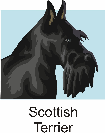
The Miniature Schnauzer is a little larger than the toy dog breeds and is actually classified as a separate breed from the Standard Schnauzer and the Giant Schnauzer. This down-sized miniature breed has a similar look to its larger schnauzer cousins and the same grooming requirements. This miniature breed’s outer coat is rough and wiry with a dense undercoat. It has the characteristic ‘Schnauzer look’ with long hair on the beard, eyebrows, moustache and legs. Colors range from light and dark grey (called ‘salt and pepper) to black or black with silver markings. Miniature Schnauzers stand 12 to 14 inches tall at shoulder height and usually weigh less than 16 pounds.
This miniature breed is lively, pleasant and playful with an expressive personality. These loyal and devoted small dogs want to be totally involved in all family activities and love to go for walks. Most of these Minis are good with children but are a little too small to be a toddler’s pet. They will generally get along fine with other family pets. Early socialisation and obedience training will help with controlling excessive barking and a reluctance to walk on leash. This breed can be taught fairly easily and can even excel at advanced obedience competitions. Minis are somewhat cautious around strangers and they make good watchdogs.
Minis have lots of energy so they need to get outside and play in the yard as often as possible. These mini-Schnauzers also appreciate a daily walk.
Show dogs need to be professionally groomed every 6 to 8 weeks when they will hand pluck the dead hair. Pet owners should brush and comb the coat several times per week and give a daily brushing and cleaning of the Mini’s beard and moustache and bottom. Excess hair should be clipped between the pads of the feet and excess hair removed within the ears. Some Mini owners may opt for a more convenient clipping. Miniature Schnauzers do not shed and if properly groomed can be suitable for someone with allergies. This breed is sometimes referred to as ‘hypoallergenic’.
